
- •29 Word study Verbs and related nouns
- •34 Language study Describing a process
- •3 6 Writing Describing a process
- •Tuning-in
- •66 Writing 2 Ordering components
- •74 Tuning-in
- •81 Listening
- •82 Language study Would
- •In the future, electronics are likely to become even more common in the home as multimedia entertainment systems and computer-controlled robots are developed.
- •Rf carrier
- •Introduction to Electronic Systems
- •16 Weeks X 2 VI hours
- •When is the lunch break?
- •10 These tolerances may seem to reflect poor manufacture but in most circuits they are, in fact, quite satisfactory. Relaxing the tolerance enables the makerto sell them more cheaply.
- •X varactor diode
- •Identify each of the following diodes:
- •10 The first stage consists of a transformer which steps down the voltage of the ac mains (see Fig. 2).
- •Smoothed dc input
- •15 Common is reverb (reverberation) which can make the music sound as if it was recorded in a very large building or a very small room.
- •Making a recording Places People Equipment
- •4 How is mixing down like developing and printing a photograph?
- •In this text which are additional to those given on the tape.
- •3 You must always keep an eye on the recording level.
- •1 A photodiode picks up rays from the remote control.
- •Ir diode
- •2 How many detection devices does it show? Name them.
- •4 If a burglar walks in front of a motion sensor,
- •7 A magnet on the moving part trips a switch if
- •Sensing device Used to detect
- •9V battery
- •In a frequency-modulated (fm) wave, the audio signal is combined with the rf carrier wave to vary the frequency of the carrier (see Fig. 2).
- •Af power amplifier
- •Via di Pietra Papa 00146 Roma
- •25 Die away naturally. As it dies, the current in the object reactivates the search coil. This voltage is then amplified to indicate with a sound or a flashing light that an object has been found.
- •4 The magnetic field a voltage in the search coil.
- •5 Noise is also by the low-frequency mains supply.
- •In left
- •In right о г
- •Interviewer: a test engineer. What would that involve?
- •I Is there any other kind of work you! enjoy?
- •15 Instead of recording the sound waves continuously, a drum з
- •4 These are converted to electrical signals by (use) a microphone.
- •15 Vinyl records are eliminated such as 'crackle' caused by dust and static, and 'jumping', due to scratches on the recording surface.
- •8 What might be the effect of so many people having cd players?
- •1 Unlike lPs, cDs use a digital recording system.
- •7 The electron gun in a crt a stream of electrons.
- •20 With an oscilloscope so that a visual display of the waveform can be seen.
- •45 Electrons.
- •Video cassette recorder
- •Italics from the text below. One has been done for you.
- •Vhs video-recorder mechanism
- •15 The number of iCs used in a computer, I.E. The chip count, can be reduced by connecting nand gates together to form other types of gates (see Fig. 3).
- •Integration as shown in Table 1. The 1с shown in Fig. 2 is an ssi 20 device but microprocessors used in computers are vlsi or slsi devices.
- •Input impedance low high
- •Instead of using the complicated springs, cogs, and wheels of a mechanical watch, the digital watch uses a vibrating crystal to keep time. It is accurate to one second in 10 years.
- •Vibrating crystal
- •15 Each one-second pulse triggers the microchip to send signals to the digital display to advance the numerals by one second.
- •Xdiaphragm
- •65 System.
- •1 Engineers developed optical fibre cables in the 1980s.
- •2 What is the purpose of the dielectric material in coaxial cable?
- •Insulator (e.G. Polyethylene) sheath
- •Insulator (e.G. Polyethylene) covering wire
- •25 Microwaves can be guided along rectangular copper ducts by a series of reflections from the inner walls (see Fig. 4).
- •If you make a mistake when keying in a number and you want to delete the last digit:
- •If you hold down clr,the whole numberwill be deleted and the p3 will go back to standby.
- •3 What is the difference between a mobile phone and a cellphone?
- •20 Telephone calls at the same time. To achieve this, each
- •30 Compromise between the number of frequency channels available in each cell and the interference between communications in different cells.
- •40 Calls from other cellphones and fixed telephones throughout the whole telephone system (see Fig. 2).
- •50 Call, the 8kHz signal is discontinued and the speech channel is enabled.
- •8 The signal indicates a suitable frequency channel for the call.
- •5 Converts the binary data into digital information (lines 21-22)
- •International international
- •40 As ordering goods and controlling bank accounts.
- •1 Avionics
- •2 Computing
- •3 Defence
- •1991-Present
- •1990-1991 Summer 1989
- •1 A technician with experience in servicing hospital equipment.
- •4900 University Avenue
- •If you would like to hear about outstanding opportunities in Europe to work in the expanding area of personal communication systems, write to:
- •If you can fill one of these vacancies, contact us at once.
- •I'm interested. I have the following training/ experience:
- •If a target is hit. .
- •Input signal
- •1 Manufacturing
- •2 Planning
- •3 Installation
- •4 Commissioning
- •If a target is hit. .
- •5 Maintenance
- •6 Sales
- •8 Research and Development
- •30 Large companies run their own r&d departments. Exciting
- •Induced in an inductor in opposition to the
- •Video image of the internal organs of a
- •2 [13] One side (left or right) of a stereo
- •In one unit and sharing a common
- •Voltage produced by an electrical source
- •241 Solid cylinder of metal oxide insulating
- •Video picture flip-flop /'flip йар/ [24] digital electronic
- •Instrument used for detecting pulses and
- •1 Or 0, high or low) long wave /'log weiv/ [10] range of radio
- •Voltage ac electricity supply maintain /mem'tem/ [22, 29] keep in good
- •Integrated circuit on one piece of silicon microcomputer/,maikraukam'pju:ta(r)/
- •Instrument for measuring various electrical quantities including voltage, current and resistance
- •Inputs are high natural frequency /.Naetjaral 'fri:kwansi/
- •Voltage ionizes the neon gas inside network /'netw3:k/ [26] system of
- •Interconnected devices network manager /,netw3:k 'тгепк1зэ(г)/
- •Interconnected telephone lines for use by
- •In a public telephone network which
- •Voltage which causes a component to pass
- •Various signals used in the test and
- •Integration: between 104 and 10s active
- •Voltage level from varying stable /'steibl/ [24] in a balanced state stage /steid3/ [5] circuit block: section of
- •In a circuit suppress /sa'pres/ [18] prevent a signal
- •Iks,tjemd3/ [28] switching centre for
- •Video signal teletype terminal /'telitaip ,t3:minal/ [28]
- •Images over long distances television receiver Ле1шзп n,si:v9(r)/
- •Isolating an ac supply voltage transistor /traen'zistsir)/ [1]
- •28] Cable or duct for guiding signals
- •Variable capacitor or resistor for making
- •V/VI:/[4, 11] volt
- •Vacuum tube /'vaekjuim tju:b/ [1 ]
- •Vdu /VI: di: 'ju:/ [28] visual (or video)
- •Video screen vdu terminal /VI: di: 'ju: ,t3:min3l/ [28]
- •Video recorders
- •Video-conferencing
- •Voltmeter I
In a frequency-modulated (fm) wave, the audio signal is combined with the rf carrier wave to vary the frequency of the carrier (see Fig. 2).
AF
signal
RF
carrier
FM
carrier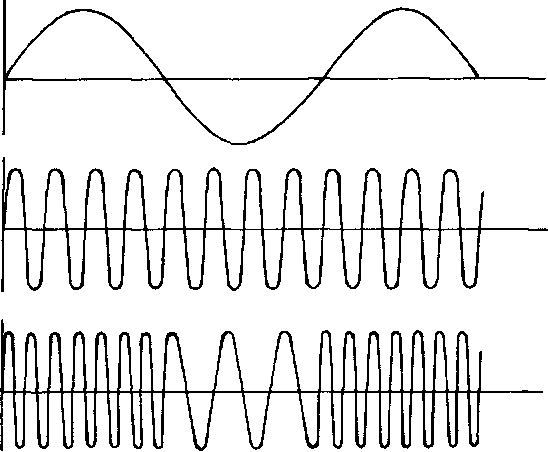
The block diagram of a radio is shown in Fig. 3 below. The tuner selects the required RF wave from those picked up by the aerial. The selected RF wave is amplified and passed to the detector, which separates the audio modulation from the RF carrier wave. The audio frequency amplifier then amplifies the audio signal to make it strong enough to drive the loudspeaker.
aerial
modulated RF carrier amplified modulated RF carrier
AF
amplified AF
RF tuner
RF amplifier
detector or demodulator
AF amplifier
Af power amplifier
loudspeaker
Fig. 3
Tuner
A typical radio tuner circuit consists of an inductor and capacitor connected in parallel (see Fig. 4). The size of the aerial inductance coil can be kept small by winding it on a ferrite rode core.
aerial
Fig. A
The RF waves fed to the tuner cause the circuit to oscillate. The impedance of the circuit is smallest and the oscillation is greatest at a 20 particular frequency known as the resonant frequency. This frequency is determined by the values ofthe inductance and the capacitance. By using a variable capacitor, the circuit can be tuned to the required radio frequency, and the selected RF wave passed on to the RF amplifier.
Task 10 Identify the waves. Use these terms:
1 FM carrier 2 AM carrier 3 AF signal 4 RF carrier
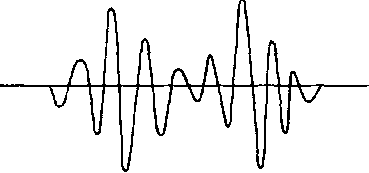
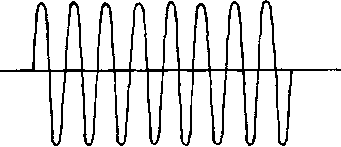
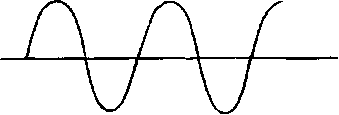
![]()
![]()
Task 11
Explain what happens at each stage in this flowchart, which shows how a radio works. The first and last stage are done for you.
Component Function
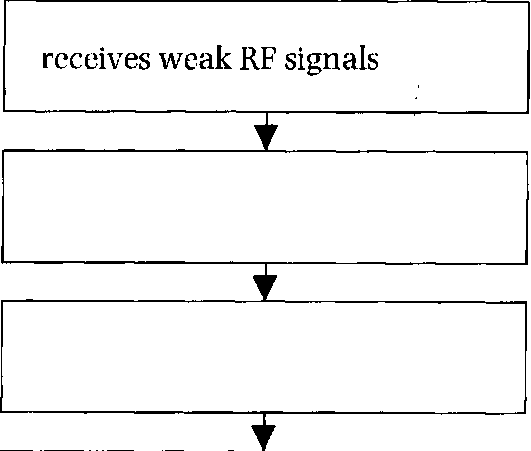
1 aerial
2 RF tuner
3 RF amplifier
4 detector

5 AF amplifier
6 loudspeaker
Writing Describing a process
When describing a process, it can be useful first to make a flowchart like the one in Task 11, showing the stages in the correct sequence. You can then expand the flowchart to include a brief description of what happens at each stage.
The next step is to turn your flowchart into a written description. You can help your readers by marking the order of the stages with sequence markers. The most common markers are:
Firstly, Next, Following that,
Then, After that, Finally,
We can summarize this advice with a flowchart:
Make a flowchart showing the |
|
main stages. |
|
|
r |
Add a brief description of each |
|
stage. |
|
|
r |
Turn the flowchart into a full |
|
description. |
|
|
f |
Add sequence markers to guide |
|
your readers. |
|
Describe how a radio deals with a radio signal. Base your description on the flowchart in Task 11.
11
Transistor characteristics
 Tuning-in
Tuning-in
Task 1 Study this table from a suppliers' catalogue of transistor characteristics. What
do these abbreviations mean? Compare your answers with your partner.
IV 2 mA 3 mW 4 MHz 5 AF Table 1
Small-signal low-frequency silicon transistors
Type |
Price |
Case |
Material |
V "ceo |
^сво |
|
lc(max) |
p tot |
TyphFE |
TypfT |
Application |
no. |
each |
style |
|
(max) |
(max) |
(max) |
mA |
(max) |
н |
(MHz) |
|
|
|
|
|
V |
V |
V |
|
mW |
|
|
|
BC107B |
20p |
T018 |
NPN |
45 |
50 |
6 |
100 |
300 |
290 a 2mA |
300 |
AF driver (comp to BC177) |
BC108C |
20p |
T018 |
NPN |
20 |
30 |
5 |
100 |
300 |
520 @ 2mA |
300 |
General purpose (comp to ВС 178) |
BC109C |
20p |
T018 |
NPN |
20 |
30 |
5 |
100 |
300 |
520 @ 2mA |
300 |
Low noise, high gain amp (comp to BC179) |
BC168C |
14p |
T092 |
NPN |
20 |
30 |
5 |
100 |
300 |
650(5 2mA |
85 |
General purpose |
BC169C |
14p |
T092 |
NPN |
20 |
30 |
5 |
50 |
300 |
6 50 <s2mA |
150 |
High gain. low noise amp |
BC183L |
Юр |
T092 |
NPN |
30 |
45 |
5 |
200 |
300 |
>125@2mA |
150 |
General purpose (comp to BC213L) |
BC184L |
12p |
T092 |
NPN |
30 |
45 |
5 |
200 |
300 |
>125@2mA |
150 |
Low noise, high gain amp (comp to BC214L) |
BC212L |
Юр |
T092 |
PNP |
-50 |
-60 |
-5 |
200 |
300 |
>60 № 2mA |
200 |
AF driver (comp to BC182L) |
BC213L |
Юр |
T092 |
PNP |
-30 |
-45 |
-5 |
200 |
300 |
>80e2mA |
200 |
General purpose (comp to BC183L) |
BC2I4L |
12p |
T092 |
PNP |
-30 |
-45 |
-5 |
200 |
300 |
> 140 @ 2mA |
200 |
Low noise, high gain amp (comp to BC184L) |
Reading Locating and applying information
Task 2
Locating information about components quickly from a table and using that information to solve a practical problem are useful skills for technicians and engineers. In the task which follows, note the time you take to answer the questions. Compare times within your class.
Use Table 1 and these explanations of the column headings to answer the questions which follow.
Heading
Case style VCE0 (max)
VCB0 (max) VEB0 (max)
Ic (max) PT0T (max) TyphFE
@IC
TypfT
Application
Explanation
transistor case and pin connections
maximum value of collector-emitter voltage with base left open-circuit
maximum value of collector-base voltage with emitter left open-circuit
maximum value of (reverse) emitter-base voltage with collector left open-circuit
maximum value of collector current
maximum total power dissipation
typical small-signal current gain (in common-emitter configuration)
value of collector current at which the small-signal current gain is quoted
transition frequency (i.e. the frequency at which the common-emitter current gain falls to 1)
recommended use for the device
1 What's the recommended use for a BC214L?
2 What's the maximum collector current for a BC169C?
3 Which transistor can be used in a complementary configuration with a BC183L?
4 Could you use a BC109C in a circuit where the collector-emitter voltage will be in the range 10-30 volts?
1 with a collector current greater than 100mA and a collector-emitter voltage between -10V and -35V?
2 with a common-emitter current gain greater than 100 and a collector current greater than 100mA?
3 which requires a common-emitter current gain greater than 200 at a frequency of 100MHz?
4 which is a low noise preamp with a collector current greater than 80mA?
5 with a collector current of 70mA and a common-emitter current gain greater ' than 600?
5 What is the common-emitter current gain for a BC168C at a frequency of 85Mhz?
Writing 1 Describing transistor characteristics
Complete this description of a BC108C using the information in Table 1 on page 63 and the explanations in Task 2.
The BC108C is an NPN transistor with a 1 style case. It can pass a
maximum collector current of2 mA.
With the base left open, the collector-emitter junction would break down at
! V. The collector-base breakdown 4 , with the emitter
disconnected, is 30V. The L._ junction breakdown voltage is 5V
when the collector is left open. These are the highest usable voltages for this transistor.
The transistor dissipates a 6__ power of 300mW. When connected in
common-emitter configuration, the small-signal current gain is 520 measured
at a collector current of mA. Typically, this gain would be
reduced to 1 at a frequency of MHz. The transistor is a
Oy
device which can be used in complementary configuration with
10
a
Now write your own description of a BC214L, based on the text you have just completed in Task 4.
Task 6
Writing 2 Ordering components Study this letter.
Satex S.p.A.
